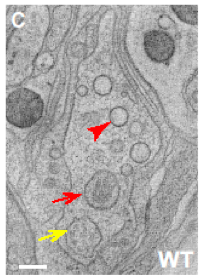Sensory systems are importance to survival and reproduction. Extracellular vesicles (ECVs) carry a wide range of proteins and offer a fairly new sensory system for animal communication. In general, extracellular vesicles are membranes surrounded structures released by cells. Within the past decade, ECVs have emerged as important mediators of intercellular communication, being involved in biological signals between cells that ultimately regulate various biological processes. However, fundamental aspects of ECVs signaling have yet to be understood due to the fact that ECVs are incredibly small in size! A recent study published this month by researchers at Rutgers University and Albert Einstein College have concluded that ECVs released by C. elegans play a role in communication and mating-related behaviors.
With ECVs being especially difficult to study, the researchers used C. elegans as a model organism to study the role of ECVs in animal communication. C. elegans are transparent nematodes about 1mm in length and prior research has mapped out the 302 neurons of its nervous system. With the use of fluorescent proteins, the researchers were able to visualize the specific sensory neurons that shed and release ECVs. The researchers using mated populations of C. elegans found that ciliated sensory neurons release particular ECVs, LOV-1 and PKD-2. Specifically, they found these ECVs were abundant in the lumen surrounding the cilium. The researchers then were able to see specific changes in male behaviors when these two ECVs were released into the environment. The males increased their tail-chasing behavior with environmental ECVs indicating that these ECVs are able to act as a local sensory cue. These key observation propos that the compositions of ECVs are able to modulate animal-to-animal communication, which is a radically new function for ECVs.

Image showing the size and location of ECVs indicated by the red arrowhead. Scale bar represents 200nm. (Wang et al., 2014)
Although the biological significance of ECVs were initially unknown, subsequent studies have shown that ECVs have a wide-range of functions as well as biological importance. This study is the first to recognize that ECVs have to ability to play a role in animal communications and mate-relating behaviors. However, additional studies need to be conducted in order to fully understand their role and implication within a sensory system. One important question that remains unresolved is how ECVs interact with recipient cells and may be an interesting line of research in the future.
Nonetheless, the significance of this study may re-shape the way people understand animal communication because ECVs are released from most mammalian cell types. Bodily fluids such as breast milk and urine contain rich levels of ECVs. Moreover, this may help understand possible communication in mother-child relationships through ECVs in breast milk.
If you want learn more about this new form of animal communication be sure to check out the original paper in this month’s issues of Current Biology.
Wang, J., Silva, M., Haas, L. A., Morsci, N. S., Nguyen, K. C. Q., Hall, D. H., & Barr, M. M. (2014) C. elegans Ciliated Sensory Neurons Release Extracellular Vesicles that Function in Animal Communication. Current Biology, 24(5), 519–525.

